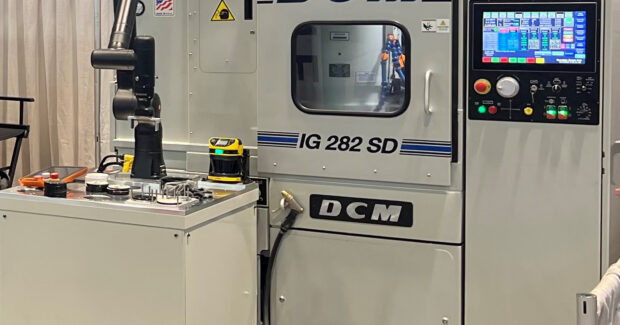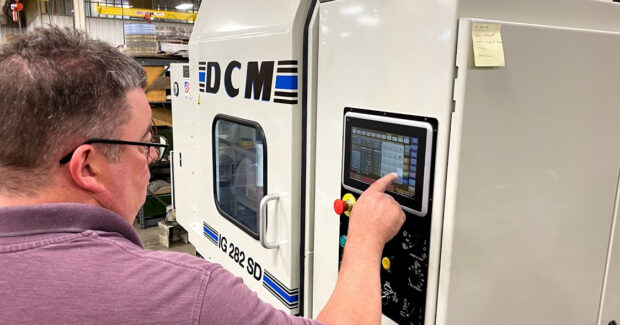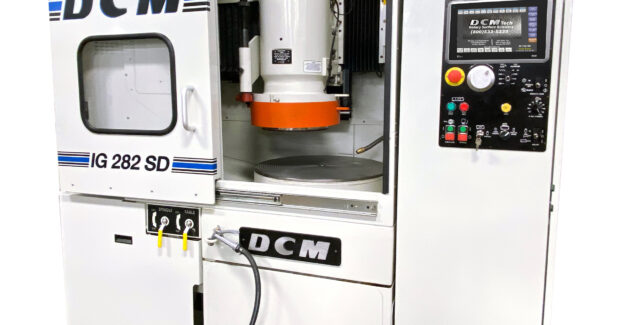Robot-Ready Grinding Systems for High-Speed Production
Advanced rotary surface grinders now come “robot-ready” to facilitate integration with third party robotic arms and fully automate the process from loading to unloading.
Posted: April 29, 2024

In the manufacturing process, it is often necessary to grind metals and alloys to certain specifications (i.e.- thickness, parallelism, surface condition). However, the process of bringing a stock sheet or plate to precise dimensions has traditionally been time consuming and labor-intensive. Although today’s automated advanced rotary surface grinders have resolved these issues to speed production dramatically, loading and unloading the workpiece typically still requires an operator.
To fill in this missing piece of the automation process, rotary surface grinders are now available in “robot-ready” versions for easy connection and integration with third party robotic arms. By adding robotics for the loading and unloading of workpieces, machine shops and OEMs with higher production demands can now substantially increase cycle times while improving precision on unattended machines.
“There are many scenarios in which a company can benefit from using robotics in the grinding process. A robotic arm can increase productivity and enable higher volume manufacturing as well as remove the operator from repetitive loading and unloading so they can move to more complex tasks. It can also minimize the handling of sharp, dangerous, or delicate parts,” says Erik Lawson, Engineering Manager at Winona, MN-based DCM Tech, a designer and builder of industrial rotary surface grinders.

To facilitate the automation of the loading and unloading of its rotary surface grinders, DCM Tech redesigned the IG 82 Series to include discrete digital I/O inputs and outputs for easy connection to virtually any third-party robotic arm. Industrial robotic arms emulate the movements of a human arm using multiple rotary joints that act as axis points. The end of the robotic arm is fitted with a fingerlike gripper, designed to safely manipulate and handle parts. These devices include a controller, actuators, sensors, software, and vision systems, if needed.
Once programmed by the integrator, the robotic arm will load and unload the part, as well as clear away any debris before repeating the process.
“The addition of robotics to our automated rotary surface grinders is a significant step that moves our industry toward providing solutions that are more fully automated,” says Lawson.
With vertical spindle, rotary table surface grinders, the table rotates with the workpiece held firmly in place underneath a vertical spindle. The grinding is not performed by the peripheral edge of the wheel, but by the entire diameter of the abrasive surface, which facilitates grinding performance and consistency. The surface grinders are designed with advanced sensors and controls that automatically maintain very tight tolerances, removing material down to within one ten-thousandth of an inch of the final thickness.
According to Lawson, the IG 82 series grinders already provide advanced features that minimize or eliminate operator intervention after set-up.
One example is the part detection system, which automates the initial contact between the abrasive wheel and the part. In the past, this typically had to be finessed by the operator. With this updated option, advanced sensor technology detects vibration and can automatically fine-tune not only the pressure of the spindle motor but also how quickly it moves the wheel down onto the part. When the machine senses the abrasive wheel has contacted the part, it automatically begins the grind cycle.
Automatic part detection eliminates the need for the operator to do time consuming, error-prone ‘manual touch-offs,’ where they would manually feed the grinding machine until it just touches the surface of the part before backing off and restarting it.
To increase production, “the grinders offer three grinding modes: conventional, incremental, and grind to height, which starts aggressively and then becomes increasingly more precise when nearing the desired outcome, says Lawson. “For greater automation, a continuous grind setting is also available, in which the machine automatically cycles through all three grind settings.”
For high-volume production, it is also necessary to periodically dress the grinding wheel. It is vital to remove grains, clogs, and excess bonding material so the wheel can return to its original surface finish and sharpness. Dressing is also used to help restore the wheel’s shape, which changes with wear. The IG 82 series comes with a programmable auto-dress capability with selectable dress frequency. “This eliminates the need for time-consuming manual dressing and improves production uptime,” says Lawson.
The advanced rotary surface grinders are already much faster than conventional reciprocating grinders because the units can get much closer to the required dimensions before any finishing steps. This capability can reduce or even eliminate some lapping and polishing steps.
With a conventional surface grinder, if stock with standard thickness needed to be ground down, an operator would stop short of the required removal and leave an unpolished surface. Using another machine was often required to remove the remaining material, but this could involve excessive time and labor.
According to Lawson, a rotary surface grinder will usually finish the work of a reciprocating grinder in a fraction of the time. For the manufacture of carbide blocks, one OEM was able to document a 14X improvement in cycle time by replacing a reciprocating grinder with a DCM rotary surface grinder.
In addition, programmable Human Machine Interface (HMI) controls allow operators to enter virtually any requirement into a touch screen at setup. This capability enhances processing flexibility, so it is easy to adjust any grinding factor to prevent an issue from reoccurring.
For routine processes, the use of a variety of grind “recipes” with sets of parameters for specific parts can further speed production, enhance quality, and aid in quick changeover. Different grind recipes can be set for different customers, material types, or even part numbers so complex programming or data does not need to be entered at the start of each job. A new recipe can be created for job variations, such as a different finish or number of parts.
According to Lawson, the automation already provided by an advanced rotary grinder combined with a robotic arm will allow the operator to set up the machine and then attend to other tasks. The machine does not need to be constantly monitored because it has built-in load monitoring. “Load monitoring allows the user to set limits, so the machine does not overtax the part being ground or overload the spindle. If something a little unusual happens, it can continue without interruption or shutting down,” says Lawson.
As manufacturers and machine shops seek to become more productive and competitive, using robotic arms along with automated grinding systems will increasingly become a best practice technique for high-volume facilities.


















